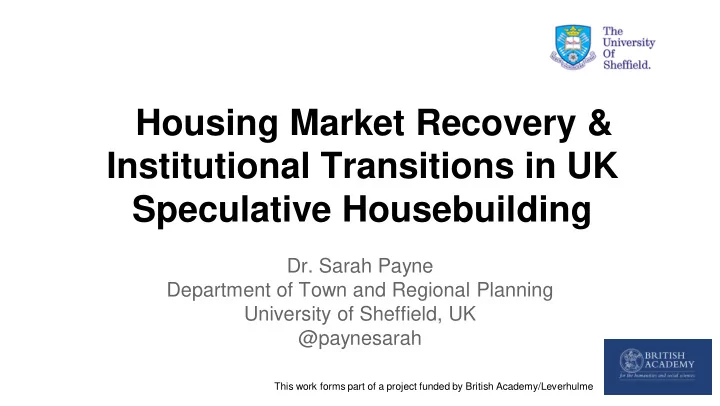

Housing Market Recovery & Institutional Transitions in UK Speculative Housebuilding Dr. Sarah Payne Department of Town and Regional Planning University of Sheffield, UK @paynesarah This work forms part of a project funded by British Academy/Leverhulme
Research Focus • Very different ‘institutional’ characteristics of this housing market recovery • Facilitating demand assumes housebuilders will respond to price signals & increase supply Unpacks inherent assumptions around housebuilder behaviour Asks what limits or stimulates supply as recovery phase takes hold Questions whether price signals alone are likely to stimulate supply behaviours
Aim “To investigate what changes housebuilders have made to their business behaviours since the onset of the recovery; and, evaluate whether they have the institutional flexibility to increase housing output as the recovery phase takes hold” Are institutionally-constituted behaviours constraining new housing output? What policy measures might be necessary to achieve UK Government’s building ambitions
Context: UK Housebuilding • Government outsources housebuilding to the market • Volume/super housebuilder dominance: Top 15 = c.50% • Business success contingent on land acquisition & construction efficiency; not product design • Policy intervenes but it’s contested; exhibits bias; can be unresponsive; takes a site/house focus: • local/site-based externalities (compensated via plan system) • quality & minimum standards (through building regulations) • Emerging tension over form / extent of intervention to increase supply & facilitate economic recovery & growth
Context: UK Housing Market • In ‘crisis’ (Stephens 2011; Sarling 2013) • Long standing supply / demand imbalance • GFC exacerbated long established tensions: • shortfall in quantity when set against pop growth • high house price / income ratio; affordability issues • Lowered ‘effective’ demand for owner occupation • Shifting tenures; increase in private renting Presents turbulent context for housebuilders ’ speculative activity
Context: Impact on Housebuilding • GFC & reduced sales (growth) has undermined financial health of housebuilders • Hangover from debt & financial shock to system • Stalled / mothballed sites • Consented sites (c.350K units) may not be delivered; based on dense ‘boom’ schemes (flats) • Strategic focus on growing profits not volume • Output focused on healthy markets (SE) • Worsening imbalance between supply & demand (Whitehead & Williams 2011)
Framing: Housing Analysis 1 • Common fundamentals that characterise UK housing system (Whitehead & Williams 2011) • Fiscal system favouring owner occupation • Highly deregulated finance market • Volatility in house price & market activity • Continuing inadequate supply response • Often used to frame analysis & shape policy responses
Framing: Housing Analysis 2 • Also, link between housing systems and macro economy emphasised (Brookes & Ward 2013 etc) • Puts fiscal measures centre stage in formulation of policy responses • Focus on ‘supply demand nexus’ • Focus on fiscal instruments to improving housing supply & market stability
Solution?: Dealing with Volatility Stephens (2011) Improve underlying balance between supply and demand to reduce volatility & underlying inflationary pressures Short term focus on fiscal measures Long term focus on supply increase • Key delivery agents = market housebuilders
Solution?: Increasing Supply • ‘Structural’ focus on planning syste m • Fiscal focus on facilitating demand & supply • Help to buy, help to build, small scale finance initiatives • But, the solution(s) still remains elusive • Clearly, a step change in output (& business practices) of housebuilders is required… What do we know about their capacity? Will they respond to demand-led price signals?
Q: Housebuilder Capacity? • Little reason to increase output whilst uncertainties remain (Whitehead & Williams 2011) • Policy responses not yielded significantly increased output from builders (just profits…?) Ongoing under emphasis on role of housebuilder behaviour in ‘recovery supply’ Gap in understanding of complex interplay between builders, policy & market
Research Proposition: Framing Capacity in Recovery Understanding impact of increased institutional & development risk in housing model: • Demand side constraints (access to mortgage finance; latent demand not expressed as effective demand) • Supply side constraints (land supply; plan sys; landowner expectations; building finance, skills gap, materials supply) • Organisational pressures to grow profits - refocusing activities in healthy markets to build profits not volume • Policy pressures around ZCH, ‘green growth’ & quality standards Brings into question: • Role & effectiveness of (only) demand-led market signals • What stimulates or limits builder development activity in recovery
Application: Framing Capacity in Recovery • Policy makers & planners need a more nuanced understanding of housebuilder behaviour than current forms of policy and engagement are able to provide Do housebuilders have institutional flexibility / capacity to increase output as recovery phase matures? Will price signals alone stimulate supply? What institutional challenges unrecognised by policy might be constraining output? What might prevent excessive impact on housebuilders from future market shocks?
Concept: Institutional Framework • Housing provision does not exist in vacuum (Ball 1983) • Market actors decisions embedded in & sensitive to change, esp. policy, economic & political change • Influencing effect of broader social & economic forces (Cars et al 2002) • Academic focus on new forms of governance capacity (Vigar et al 2000) & relations between actors (Healey, various) • Approach emphasises social relations, networks, informal customs, conventions & relationships • Focus on process, not theoretical end state (equilibrium) • Impact of institutional ‘shocks’ & transition?
Summary Contribution: The Institutional Transition of Recovery in UK Housebuilding • Recovery & transition imply change • State’s housing supply aspirations currently contingent on delivery capacity of market • Reframes relationship between state and market in provision of new homes • Housebuilder capacity contingent on specific institutional arrangement s • Challenge assumption that price signals alone will stimulate supply • ……….or have we been here before?
Any Questions? s.payne@sheffield.ac.uk 0114 222 6939 @paynesarah This work forms part of a project funded by British Academy/Leverhulme
Recommend
More recommend